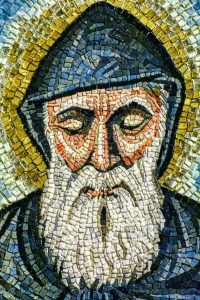In Praise of the Real St Patrick
by Nadia Ramoutar MMM Communications Coordinator Ireland 16.03.2024
 I lived part of my life away from Ireland and then I really dreaded St Patrick’s Day. The cheap green plastic beads, dyed beer, loud drunk groups wearing buttons or t-shirts with slogans like “kiss me I’m Irish” made me want to hide under the covers in bed. This was not the St Patrick’s day of my Irish Childhood nor was the behaviour befitting of the man behind the holiday, St Patrick.
I lived part of my life away from Ireland and then I really dreaded St Patrick’s Day. The cheap green plastic beads, dyed beer, loud drunk groups wearing buttons or t-shirts with slogans like “kiss me I’m Irish” made me want to hide under the covers in bed. This was not the St Patrick’s day of my Irish Childhood nor was the behaviour befitting of the man behind the holiday, St Patrick.
We know that turning a special holiday into a commercial day of profit is not new by any means, but I do feel that globally St Patrick’s Day is often ambushed by the worst of stereotypes about being Irish. So let us set the record straight. St Patrick is a man most worthy of being a Saint and being revered.
Perhaps the first point of interest about St Patrick, is that he was not Irish. As a young boy he was kidnapped and brought to Ireland as a slave. He was a young Roman living in Britain who was snatched and taken across the sea to Ireland. This was the first of many major challenges that St Patrick encountered in his life.
Let’s just say that 5th Century Ireland was no picnic. It was a challenging and conflicted place. There are myths and legends about St Patrick, but he was an admirable man who may not have been the first Christian in Ireland, nor was he even the first Bishop. He was, however, a man of courage and bravery who escaped slavery, went back to Britain and rather than accepting a life of prior privilege took a harder path returning to Ireland again to follow his faith.
Near the end of his life, St Patrick wrote two lengthy letters in Latin that survived which give us some insight not just into his life, but also into his heart. In these letters, St Patrick expressed his profound concern for the women of Ireland, many were enslaved and faced brutality and abuse on an on-going basis.
So many obstacles were in St Patrick path, but he didn’t turn his back on challenges or injustice. He was determined to face danger and to make Ireland a better place. He went from being a scared boy on a hill in a foreign country with only sheep for company, to being a shepherd of people guiding and protecting them. St Patrick was not a meek and mild saint, but stood up for what he believed and admitted to his own flaws and failings.
When I was in Tanzania, Africa recently, my colleague Sr. Sheila and I became fascinated by the young boys we saw herding sheep and other cattle on the side of major roads. It was so different from how children in our Western culture are raised. As we saw them busy in their role or occasionally sleeping under a tree letting the animals wander, I thought, “who knows, that boy might grow up to be a Saint like Patrick.”
SEE ALL BLOG POSTS
